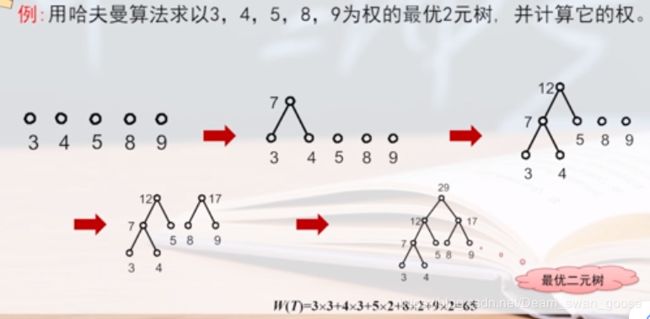第五章 树和二叉树 —— 哈夫曼算法
哈夫曼算法
---------------------------------------↓↓↓↓↓↓↓↓↓↓↓↓↓----------------------------------------
以下部分转载自:https://blog.csdn.net/harington/article/details/84202659
本人对该博主的代码加以修改和注释。
赫夫曼树的编码 代码 解码 建树过程
现在让我们一步一步构思
从最简单的开始,先给你 A B C D 4个节点 权值分别为 5 4 2 7
把他们一起存到一个数组内,然后 遍历 找到2个权值最小的 节点相加然后加入数组,标记一下,这两个及节点就被删除了,两个节点相加得到新的节点,加入到数组中,之后再继续 遍历 找到权值最小的两个点,继续重复上述操作,直到所有前面的 最初的 4 个节点都用过。(下面数组我们对第0列弃用,方便填下标)
| 下标 | 0 | 1 | 2 | 3 | 4 | 5 | 6 | 7 |
| weight | 0 | 5 | 4 | 2 | 7 | 0 | 0 | 0 |
| parent | 0 | 0 | 0 | 0 | 0 | 0 | 0 | 0 |
| lchild | 0 | 0 | 0 | 0 | 0 | 0 | 0 | 0 |
| rchild | 0 | 0 | 0 | 0 | 0 | 0 | 0 | 0 |
我们进行第一次遍历 找到最小的两个数 4 2 然后让他们作为左右子树构造成一个 二叉树 将这个 新的权值 2+4 = 6填入到下标第一空的地方,将 2 和 4 的parent 改为 新建权值的下标 将 新建节点的左右子树 改为两个节点的 下标
| 下标 | 0 | 1 | 2 | 3 | 4 | 5 | 6 | 7 |
| weight | 0 | 5 | 4 | 2 | 7 | 6 | 0 | 0 |
| parent | 0 | 0 | 5 | 5 | 0 | 0 | 0 | 0 |
| lchild | 0 | 0 | 0 | 0 | 0 | 2 | 0 | 0 |
| rchild | 0 | 0 | 0 | 0 | 0 | 3 | 0 | 0 |
之后继续遍历 weight 从第1个 到 第5个 找到 权值最小的两个(2 和 4已经被用过了)找到 5 和 6,继续建树 。新建树的权值为 11 ,然后改 5 和 6 的parent 为 新建权值的下标 6.改新建权值的 lchild为 1 。rchild 为 5。
| 下标 | 0 | 1 | 2 | 3 | 4 | 5 | 6 | 7 |
| weight | 0 | 5 | 4 | 2 | 7 | 6 | 11 | 0 |
| parent | 0 | 6 | 5 | 5 | 0 | 6 | 0 | 0 |
| lchild | 0 | 0 | 0 | 0 | 0 | 2 | 1 | 0 |
| rchild | 0 | 0 | 0 | 0 | 0 | 3 | 5 | 0 |
然后我们继续遍历找到 7 和 11 继续建树,加到数组的最后一个位置 改 7 和 11 的parent 改为 7, 新建节点18 的lchild 为 权值为7的下标4 .新建节点18 的 rchild 为权值为11 的下标6.这时所有的节点都用完了,我们构建赫夫曼树完成。
| 下标 | 0 | 1 | 2 | 3 | 4 | 5 | 6 | 7 |
| weight | 0 | 5 | 4 | 2 | 7 | 6 | 11 | 18 |
| parent | 0 | 6 | 5 | 5 | 7 | 6 | 7 | 0 |
| lchild | 0 | 0 | 0 | 0 | 0 | 2 | 1 | 4 |
| rchild | 0 | 0 | 0 | 0 | 0 | 3 | 5 | 6 |
然后求每个字符的Huffman编码。
举个例子,先找第一个 字符的huffman编码,也就是权值为 5 的赫夫曼编码,
1)先构建一个栈。
2)然后找第一个字符的 parent,判断是lchild 还是 rchild。(parent 是 6)找到下标为6的列
3)判断是lchild 还是 rchild。如果是lchild 则向栈中 压入0,如果是rchild 则向栈中压入1.(左孩子,把0压入栈中)
4)然后继续找parent。(找到6(权值11)的parent,下标为 7),重复操作 (3)操作(4)直到 Parent 变为0结束(也就是根节点)。然后弹栈,用一个数组接收。
然后我们求出第一个字符的 赫夫曼编码是 10
实验题:
给定报文中26个字母a-z及空格的出现频率{64, 13, 22, 32, 103, 21, 15, 47, 57, 1, 5, 32, 20, 57, 63, 15, 1, 48, 51, 80, 23, 8, 18, 1, 16, 1, 168},构建哈夫曼树并为这27个字符编制哈夫曼编码,并输出。模拟发送端,从键盘输入字符串,以%为结束标记,在屏幕上输出输入串的编码;模拟接收端,从键盘上输入0-1哈夫曼编码串,翻译出对应的原文。
- 模拟发送端
输入:I love you
输出:01101111011110011100000010111100011100100001 - 模拟接收端 输入
输入:01101101111011000111111010111101101001100001
输出:it is a dog
代码如下:
#include




